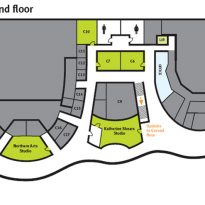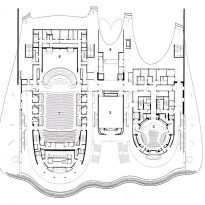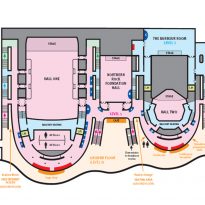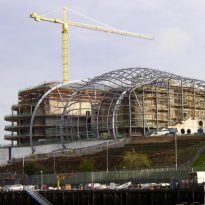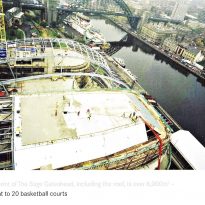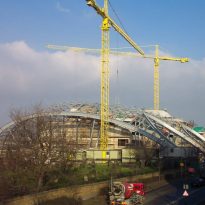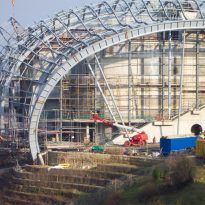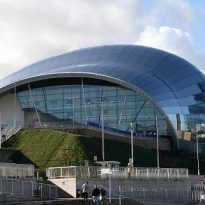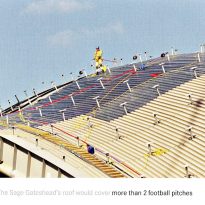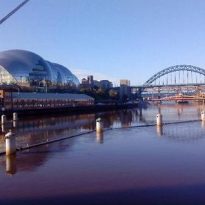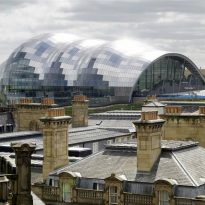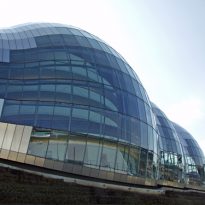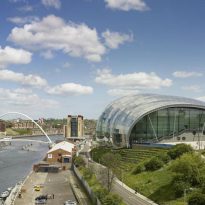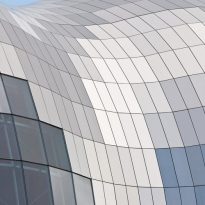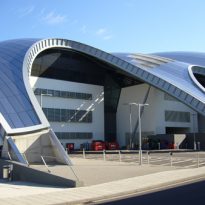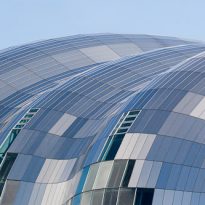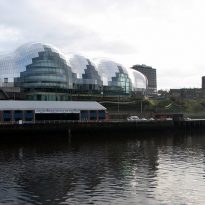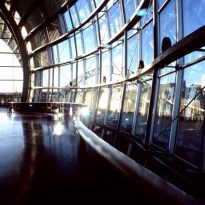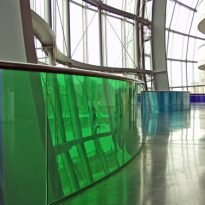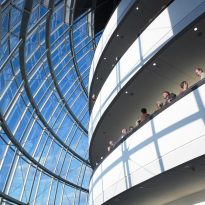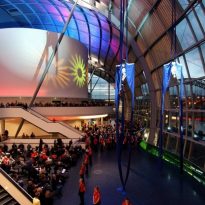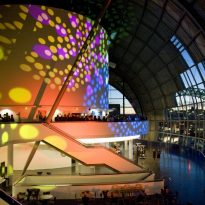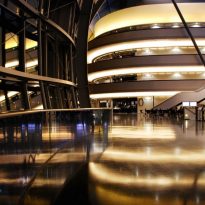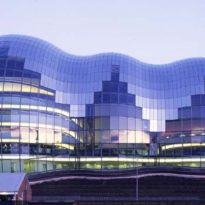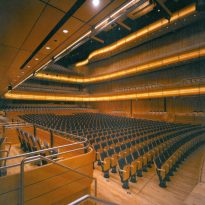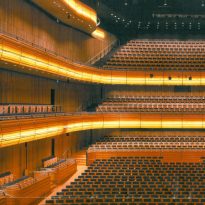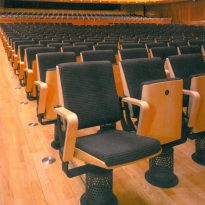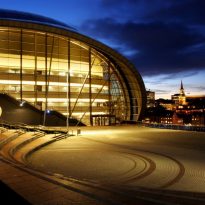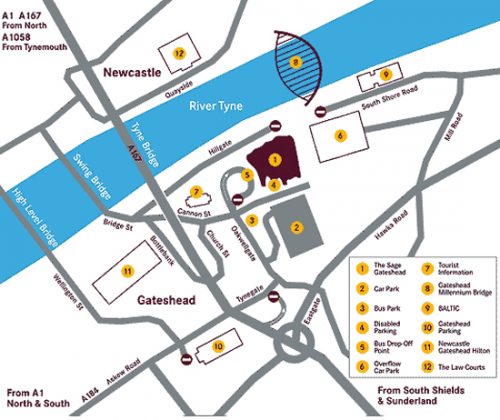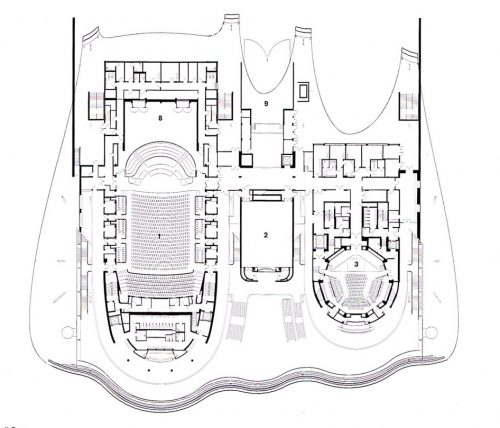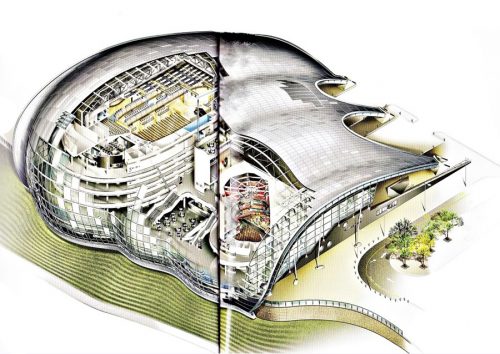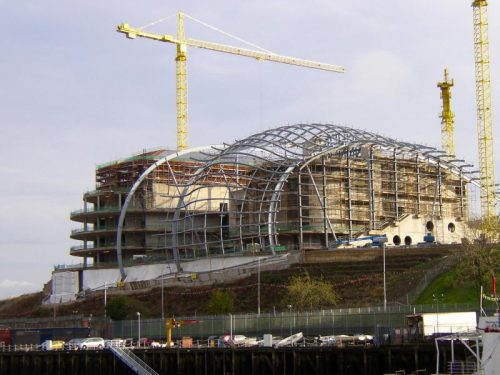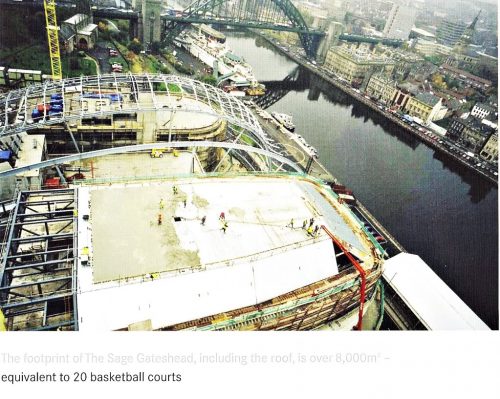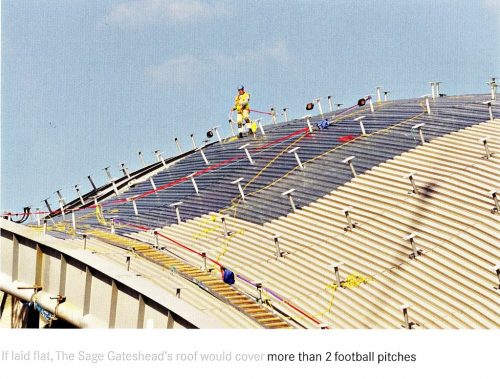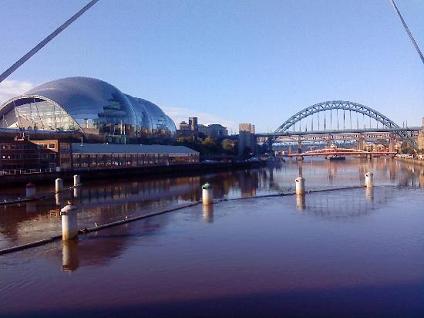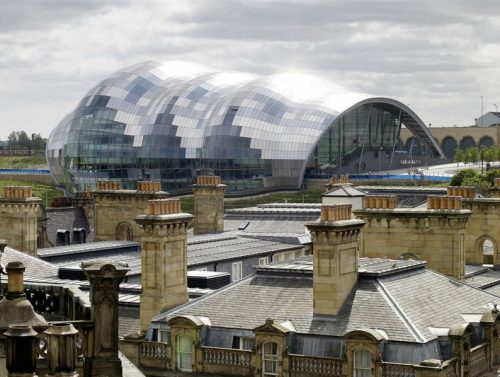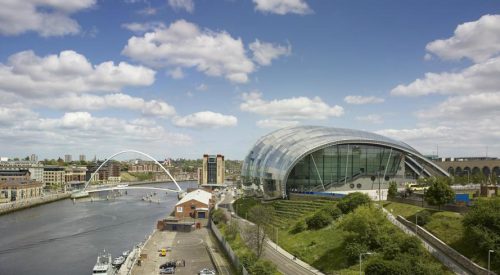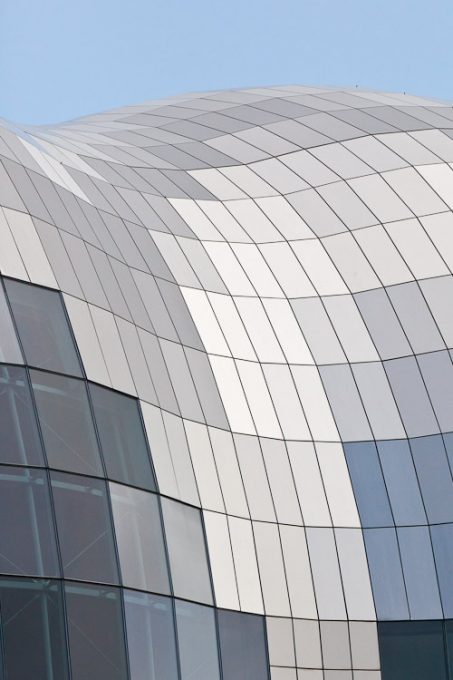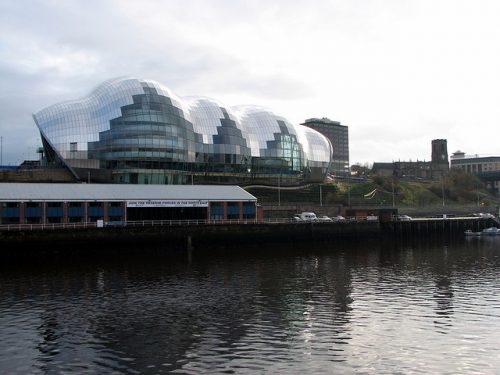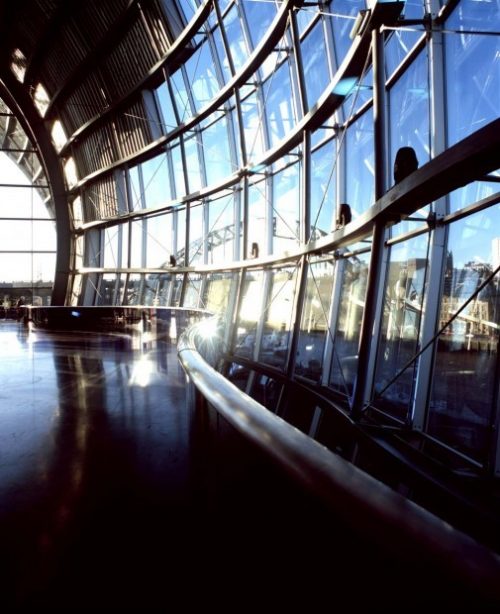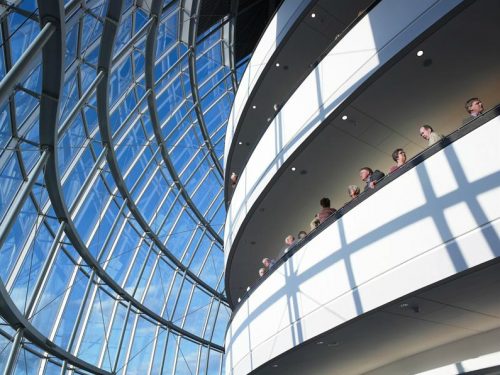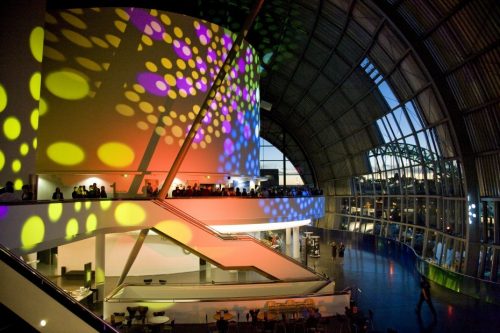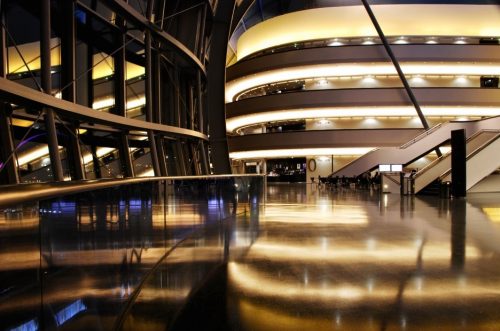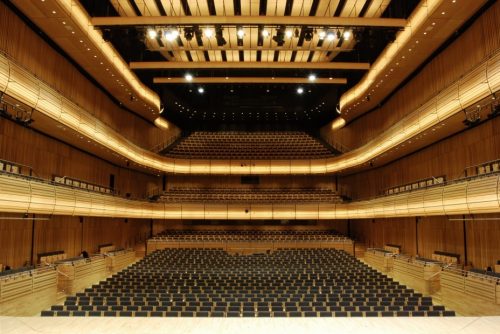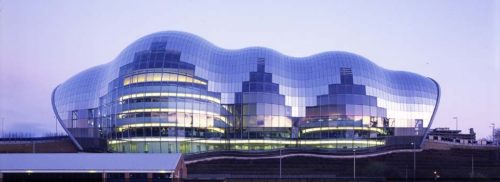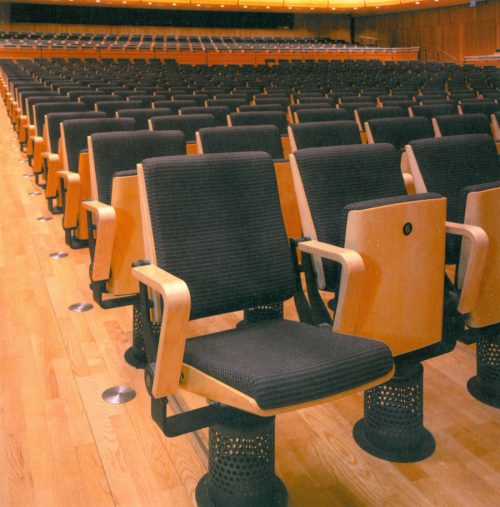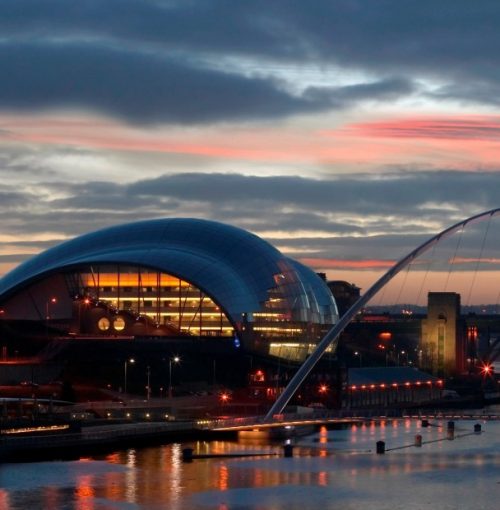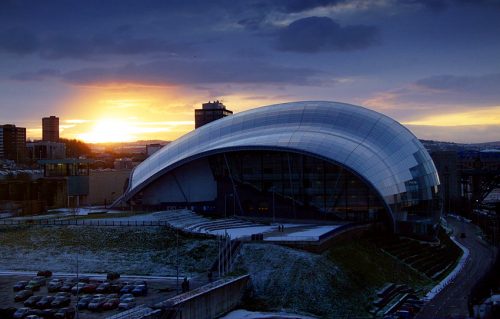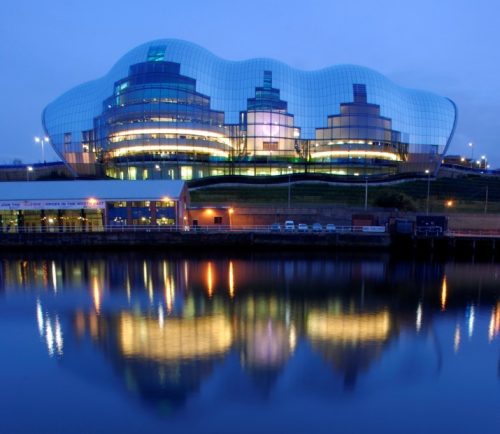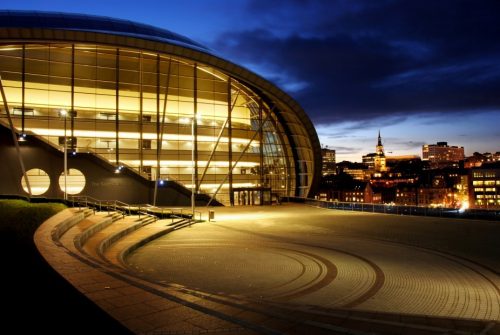The Sage Gateshead Auditorium

Introduction
The Sage Gateshead is one of the great social spaces of the city, while regional music center with international prestige. This is the first foray Foster & Partners in the projection of a building dedicated to the performing arts. The new space was designed after extensive consultations with the public and with the musicians, filling a void for musical events in the Northeast and in turn the position of Tynesides established itself as an arts destination in its own right.
Even before it opened The Sage Gateshead had already won the 2004 Robert Stephenson for concept and design. Since its inauguration has received numerous awards: Best Public Building Award in 2005, given by British Construction Industry, the RIBA Inclusive Design Award, the Gold Roses Design Award, the the RICS North East Renaissance Award for Design and Innovation and Tourism and Leisure 2006 Civic Trust Award.
Situation
The building was erected on the banks of the River Tyne, in St Mary’s Sq, Gateshead Quays, Gateshead, Tyne and Wear NE8 2JR, England and has become a local landmark and heart of an interesting project from the time of its completion regeneration overlooking the front on both banks. It is located next to the new pedestrian Baltic Millennium and Tyne Bridge, with its large arch that is repeated in the form of the cover of The Sages.
Tyne and Wear is a metropolitan county in north eastern England, on the mouth of the Tyne and Wear rivers. It emerged as a metropolitan county in 1974 after the passage of the Local Government Act 1972. It consists of five metropolitan boroughs South Tyneside, North Tyneside, City of Newcastle, Gateshead and Sunderland City.
Concept
This impressive milestone in the Tyneside is a remarkable combination of better acoustic performance, striking aesthetics and sustainable design. The complex, undulating torso horizontally, or “armadillo” as some critics have labeled protects three separate main spaces with a wide and surround roof shrinks as cellophane around the building and extends over the public space.
Spaces
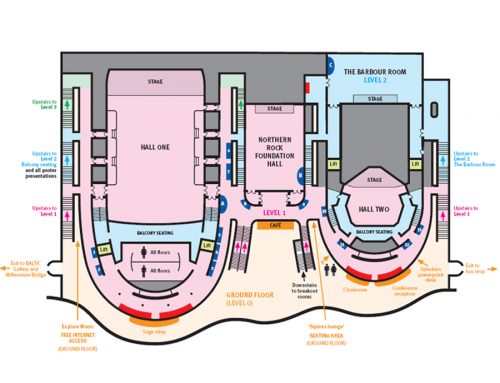
The three main independent spaces, white exterior and pure lines, have their own life under the blue cover armadillo and converge in a spacious hall, crossed by walking in and out of the vault along the riverbank.
Each auditorium was conceived as a separate enclosure, but due to strong winds blowing along the coast thought it best to group them under a single cover protector. As a result, the assembly is protected by a wide roof shell which extends in the open area and to be retracted beneath the supports. Inside addition to the auditoriums are four bars, shops, an information center and locker.
In turn the esplanade is a major public space that acts as an entrance hall to the auditoriums and a common room for the School of Music beneath. The public areas have been reduced to a minimum to encourage artists to interact with students during the day and mingle with your audience overnight.
The Sage provides three independent auditoriums, houses the Regional School of Music and also acts as a base for the Northern Sinfonia and Folkworks, which promotes folk, jazz and blues performances.
Auditoriums
- Room 1

The largest of the auditoriums is acoustically “art art”, with seating for 1650 spectators. This spectacular auditorium has sophisticated movable panels that descend from the ceiling and walls are also lined with acoustic panels of wood. Designed with the highest international standards, its atmosphere can be modified to suit any conference or event, with adaptable for wheelchair seating.
- Room 2
The second room is used for folk music, jazz and chamber music, with a provision of informal and flexible seat is designed to complement the Board 1. It has a maximum capacity of 400 people and has an area of ten sides. Its more casual and intimate atmosphere make it ideal for presentations, debates and conferences. When used as a theater has a capacity of 330 people, if it becomes cabaret to 70.
- Northern Rock Foundation Hall
The third space is a great rehearsal for Northern Symphony and is the focus of the School of Music also has other 26 rooms. This impressive lounge with wooden acoustic panels is located in the center of the building and completely soundproofed. Music Education Centre also offers 26 rooms with variable capacity from 3 to 70 people, as required.
With its dramatic appearance and the glass towards the Esplanade, this Hall creates a unique and theatrically huge space, ideal for presentations, launch parties, banquets and conferences. The room also features a cantilevered platform where your team stands lighting and sound. Its capacity varies with use, as theater seating for 230 people at a reception 250, 150 in a banquet, cabaret 105 or 50 for boardroom.
- The Barbour Living
The Barbour Hall is located behind the Hall 2 and functions primarily as a conference, events and banquets.
This versatile space with flat floor covers 258m2 and is located behind the main body of the building. It has its own balcony glass and sanitary facilities that together provide a venue for private and corporate events autonomous zone. The capacity varies from 300 to 50 participants, with a small and basic scenario.
Other venues
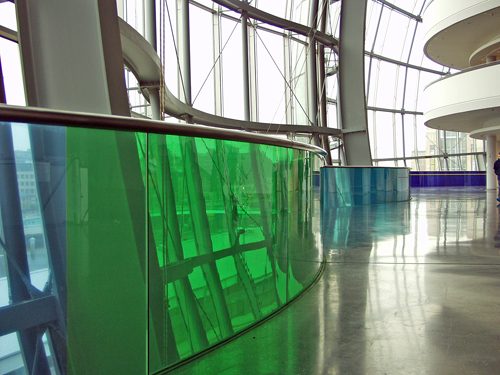
- Esplanade
The lobby areas have exceptional views across the cityscape over the River Tyne at Newcastle and offering seating areas, cafes and restaurants. A colored glass balustrade runs along the front of the esplanade and connect with public walkways outside the building.
- Squires Seminar Room
The Squires Seminar Room is a secure room located on the Esplanade downstairs. It has an AV equipment projector and screen making it ideal for small meetings, presentations or storage room large meetings in the largest rooms.
- Entertainment Boxes
Surrounding Hall 1 and at levels 2 and 3 are some small rooms “Entertainment Boxes” that work well for workgroups, small meetings, interviews, offices or reception areas. Each of these rooms has an audio channel to listen, simply pressing a button, what is happening in Hall 1, Hall 2 or Northern Rock Foundation Hall.
Structure
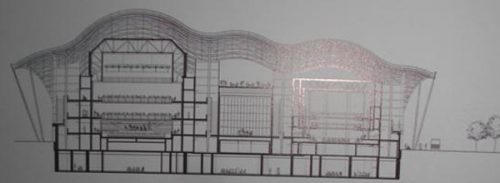
Under the horizontal structure of steel and glass, supported by four steel arches with a span of 80 meters, three separate and independent structures of reinforced concrete and pure lines, an auditorium for 1700 people, a second room with 400 seats and develop School of Music and rehearsal room for the Symphony Orchestra. To support the massive structure of the complex has been drilled and slotted floor approximately 1,100 piles of concrete and steel, completing the foundation with concrete spill 18,000m3. Each zone is separated from the others to prevent noise transmission through the structure.
Hidden under the cover of Architectural roof appears a complex interface between the concrete layers of the three rooms and the steel parts of the roof.
In Room 1 under the roof trusses, hanging baffles suspended six 20m by 6m wide. These heavy wooden buildings with steel frames 15tn weigh each and can be upgraded or downgraded, may alter the internal acoustic architecture.
Materials
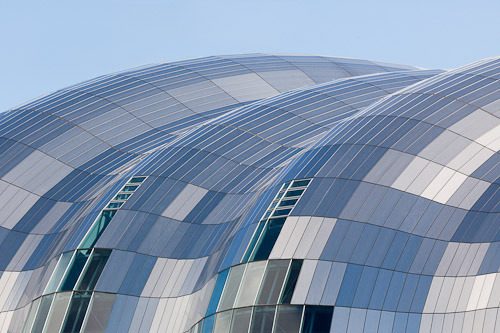
The dramatic curved roof, which weighs 750 tonnes, is composed of 3,000 stainless steel panels and trapezoidal panels 250 flat glass. If the ceiling plane is placed, its 12,000 square meters would be sufficient to accommodate two football fields. Each stainless steel panel, 4m long by 1m wide, has a linen finish to reduce glare. Each panel is solid and is designed to prevent noise of heavy rain may cause a distraction during concert performances.
In the remainder of the steel structure also used. Most of the 3,858 tons used in the structure are hidden in the foundations, walls and floors
- Esplanade walkway
Gateshead City Council commissioned the artist Kate Maestri conducting colored glass balustrade that runs 200m along the front of the Esplanade. It consists of 101 total panels and weighs 8224 kilos.
- Wood panels
To provide the necessary acoustic, in Hall 1 an adjustable coffered ceiling and a coating system with wood paneling American ash was used. Roof panels are movable, being driven by a computer independently for optimal acoustic reverberation.
Each roof deflector comprises numerous opposing sections formed with two layers of 6 mm birch plywood, marine, adhered together to achieve the correct bend radius for better sound deflection
The wood paneling on the walls was performed directly on the concrete. To achieve the required curvature by acoustic designers MDF layers, moisture resistant, finished with solid plates ash and wood profiles thereof were used.
In Room 2 panels are of European birch.
- Seats
The seats in the main hall were placed in a concave shape to maximize the view of the stage. Each seat has an adjustable bending soil, which flows the air conditioning up, getting huge energy savings because the air conditioning does not exceed two meters.
- Sustainability
The building is oriented north-south to avoid sun impact and only air conditioned auditoriums.
Sustainability was a key element in the design, with aspects that contribute to energy consumption 40% lower than the best practices so far. Including the use of thermal mass in both heating and space cooling, natural ventilation and sun protection. Other features of this design are sustainable heat recovery on all floors, a high degree of thermal insulation and energy efficient lighting.
Video

